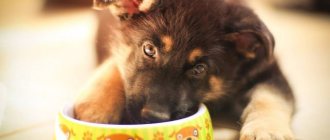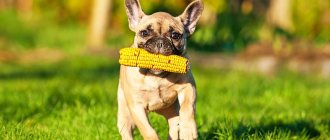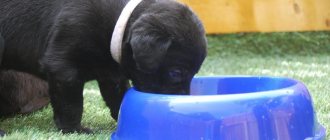The puppy’s growing body requires increased attention from the owner; the baby’s digestive system is not yet accustomed to solid food. The younger the puppy, the more closely its owner needs to monitor its nutrition. Any mistake in diet planning can cause significant damage to the baby. It is at a young age that the puppy develops basic eating habits, which will later be very difficult to correct. We will tell you further about what foods should be present in the diet of all puppies and how many times a day very young pets should be fed.
What to feed a puppy
How to feed a puppy correctly?
Do you want to know what you can and what is the best way to treat your little furry so that he turns into a beautiful and healthy dog? Then we will try to delve deeper into this difficult issue. Experienced dog breeders do not consider this topic particularly problematic and feed the puppy “automatically,” so to speak. But someone who got a dog for the first time has a million questions about nutrition at the same time, and everything needs to be answered immediately, since a living creature will not wait.
It is very important not to overfeed the puppy, breaking his stomach to incredible sizes. Regular overeating has just as bad an effect on the animal's condition as undernutrition. Large breed dogs that quickly gain weight have a good chance of developing joint problems.
Next, you will learn what to feed your puppy, how to choose the right combination of foods for the menu, and also what foods should be kept away from the dog.
How to properly feed a puppy natural food?
The first thing a dog owner should understand is that his food should always be fresh. After all, for ourselves, don’t we buy meat a little cheaper and tastier? You should treat an animal with the same responsibility as you would treat your child. Poisoning from poor-quality food is a common occurrence in pets.
A dog at home is often fed natural products. It will cost a little less than dry food, and the owner can always be sure of the quality. But you should immediately prepare for the fact that now you will be faced with frequent and regular purchases, heavy bags and constant cooking, because at first the puppy eats very often. If this doesn’t scare you, let’s take a look at the list of products that the growing body of a dog of any breed requires.
Important!
Never give your puppy food from your table - such food is absolutely not suitable for him, even if it is aromatic borscht cooked with soul.
So, to feed a young dog we will need:
- Milk. A small puppy is fed milk for up to 4 months. It is vital for the pet for normal growth and development. Milk is given in its pure form or porridge is cooked with it. But here the question arises - what kind of milk should I feed? It is better if it is goat, since allergies to it are very rare. But it is not always possible to get it. Therefore, cow's milk is suitable, but not whole, but diluted, so as not to cause upset in the puppy. Closer to 6 months, the amount of milk is reduced, and then it is removed altogether, replacing it with sour milk.
- Dairy products. For good digestion, as well as to enrich the body with calcium, a young dog must be given cottage cheese, kefir, and low-fat sour cream. Not everyone knows that you can give your puppy a serum that contains a lot of useful substances, but it costs literally pennies. When the puppy grows up, the amount of fermented milk products will be much less - 2-3 times a week. Hard cheese is very useful for a puppy, which is given to him as a reward for success in training.
- Meat. It should be at least 40% in the diet or 20-30 grams per kilogram of weight. Meat is given raw, frozen, boiled or scalded. However, most of the time the puppy is fed raw meat, since the dog is, after all, a predator. It is allowed to feed the puppy skinless chicken, turkey, veal, beef, and horse meat. In addition to pure meat, meat by-products are very useful for a puppy. Like meat, they are given cooked or raw. It is very good to include a cow's stomach, udder, trachea, liver, and kidneys in the diet of a growing dog. All meat products should be cut into small cubes, but not in the form of minced meat.
- Fish. The puppy should be given fish or seafood twice a week. It can be squid, shrimp, mackerel, hake, pollock. If you are confident in the purity of the product, then boiling is not necessary. But it is better to refuse river fish. In addition to the high risk of infection with helminths, there is a chance that the puppy will choke on a bone, since they are very small and it is simply unrealistic to choose everything. Fish is given instead of meat feeding.
- Vegetables. Every baby needs vitamins. Most of them are found, of course, in vegetables. Gradually they are offered to the animal, mixed with cottage cheese or porridge. You can grate them on a fine grater and serve them fresh or stewed - this way they are better absorbed without causing upset. It is good to give the puppy pumpkin, carrots, zucchini, beets, and also add a little greens - onions, parsley, spinach.
- Berries and fruits. Many dogs love fruit. But not all owners know whether they can be allowed to eat them. You definitely can’t force a dog to eat something that is healthy if it doesn’t want to. But if your dog happily crunches an apple or picks up fallen apricots and at the same time everything is fine with his digestion, this vitamin supplement is very useful. It is undesirable to give your puppy grapes and currants, which cause bloating and accumulation of harmful substances in the body. You need to be careful with stone fruits, which contain hydrocyanic acid, as well as with bananas - they quickly make the puppy fat.
- Cereals. It is mandatory to feed the puppy porridge. But it serves only as an addition to the main milk and meat diet. Under no circumstances should your puppy eat only cereal. In the first months, baby porridge is cooked in milk. It could be semolina, rice, buckwheat, oatmeal. You need to watch how the dog tolerates this or that product. If buckwheat doesn’t work out and the dog gets upset from it, then this grain is excluded for a while.
Important! As an invaluable protein product, you can and should use egg yolks both in their pure form and in the form of an omelette twice a week, but it is better to give quail eggs.
How to properly feed a puppy dry food?
Feeding a growing dog natural food is cheaper, but the preparation process takes a lot of time. It is much easier to give your baby dry puppy food. It is properly balanced and there is no need for additional vitamins and minerals.
There are three classes of food:
- Economy;
- Premium;
- Super premium.
The last two are recommended for dogs whose owners really care about their health. Let's find out which brands of puppy food are the healthiest and most popular:
- Hill's
- Royal Canin
- Eagle Pack
- Purina Proplan
- Genesis
- Diamond
Important! If you don’t know what is best to feed your puppy, and you decide to switch your baby from natural food to dry food, then you need to do this gradually. The same applies to changing the brand of food.
Please note that it is better to give dry food to a puppy in a soaked form. To do this, half an hour before feeding, the crackers are poured with warm water to swell. You should never use broths for this - only clean water. The food packaging indicates the norms for each age. These should not be exceeded due to the risk of nutrient overdose. Owners should be aware that dry food is given less than natural food due to its high concentration and calorie content.
Important! For those who give their puppy dry food, there is good news - the number of bowel movements per day will be less than with natural food. So you will have to clean up less too.
Rules for switching to dry food
A complete transition to dry food with abandonment of mother's milk is practiced at 2-2.5 months. Until this moment, the baby is introduced to the new product through feeding.
When to start feeding puppies dry food
The first acquaintance is organized from 3 weeks of life. The pet is given a pre-soaked starter and wet canned food. Feeding too early is useless, since the newborn’s stomach is adapted to only one type of food - mother’s milk. He simply cannot digest everything else.
How many times a day should you feed your puppy?
Babies need as many meals as their age dictates. The smaller the puppy, the more often it needs to be fed. At about one month of age, puppies are allowed to feed on their own, gradually transferring them from milk feeding to regular food.
Look at the approximate feeding plan for the day;
- up to two months – 5-6 times;
- from two to four – 4-5 times;
- from four to six – 3-4 times;
- from six to ten – 3 times;
- from ten to one year - 2 times.
Keep in mind that at night, namely from 22.00 to 6.00, the puppy should have a break. There is no need to feed him even if the baby whines at night. Firstly, this is a bad habit that will stick for life, and secondly, the stomach needs rest, that is, time when it is free from food. To prevent the puppy from being hungry, he is fed milk porridge or meat at night.
Important! If for some reason you missed feeding, you cannot give double the norm next time. Feed your puppy the same as usual to avoid overfeeding.
Finding another lactating female
The first option to solve this problem is to find another lactating bitch and place the puppies with her. In such a situation, you need to know some tricks, because the dog may refuse to feed puppies that are not its own.
- In the absence of the wet nurse, it is necessary to mix her puppies with step ones. This is done by placing the puppies one at a time - one of your own, one of someone else's, and so on. This is necessary so that other people's puppies acquire the same smell as her own puppies.
- Afterwards, you need to start the nursing female and place all the puppies under her as quickly as possible. There are cases that bitches are very aggressive towards other people's puppies, so it is better to put a muzzle on her before the first procedure. In it, she will not be able to harm the puppies, as well as the person who started all this.
- After attaching the puppies, you need to remove the muzzle from the dog and, holding it by the collar just in case, watch it. If she begins to lick all the puppies, then the procedure was successful and you don’t have to worry anymore, she mistook strangers for her own. If a dog, after removing the muzzle, tries to harm other people's puppies, you need to take it away for 10-20 minutes, and then repeat it all over again.
IMPORTANT! Until the dog has licked all the puppies, do not leave them alone under any circumstances. Otherwise, she may bite them to death.
How to feed one-week-old puppies without a bitch?
Unfortunately, there are situations when the owner has to take on the role of the puppies’ mother, feeding them artificially. Feeding newborn puppies is not easy - you will have to devote all your time to this. Don't know how often you'll have to feed your babies? This will have to be done every two hours.
There are several options for feeding a puppy/puppies left without mother's milk:
- The easiest way to purchase is the so-called “bitch milk”, which is sold in powder form in packages of different capacities. The selected ingredients are as close as possible to the composition of the bitch's milk.
- The second option is to make your own formula for feeding puppies if you have cow's or goat's milk. To do this, take 3 yolks, a pinch of salt, a quarter teaspoon of vitamins (liquid) and a spoonful of corn oil per liter of milk. This mixture is brought to 35°C and fed to the puppies using a bottle with a pacifier. Babies are fed this way for up to three weeks, after which crushed regular food is gradually introduced.
Special blends
It is extremely important to choose an adequate substitute for breast milk, because it is not just food, but the only source of nutrients, microorganisms necessary for the development of the body and the creation of primary immunity in the baby. Under no circumstances should regular milk be used for these purposes.
There are two ways to replace breastfeeding for a real mother:
- Making homemade formula from cow's milk that needs added nutritional value. To do this, add 1 egg yolk, 2 drops of vitamins A, D and 2-3 ml of vitamin C (ascorbic acid) to 100 ml of liquid. The entire composition is stored for no more than a day and is heated to a warm state if necessary.
- Special milk substitutes produced industrially. This is the most suitable option, since the mixture already includes all the nutrients in the required proportions. The owner can only dilute the powder to the required consistency, following the instructions. Many manufacturers around the world produce special nutrition for breastfeeding, so you can easily find the right one.
What to feed a one-month-old puppy?
You're probably wondering at what age can you buy a puppy? There is no consensus on this matter. Some people think that it’s better early, while others believe that no earlier than 2-3 months after the end of the vaccination quarantine. Professional breeders can start selling puppies after activation, that is, at 45 days.
However, if the puppy is sold without a document, then you can buy it earlier. The owners begin to sell young animals at the age of one month. At the same time, some of them already feed babies from three weeks so that they themselves can eat from a bowl. When you bring the puppy into the house, you should prepare the necessary minimum of food for two to three days.
This list includes:
- rice/buckwheat/oatmeal;
- beef/chicken;
- beef tripe or other offal;
- pumpkin/carrot;
- cottage cheese and kefir;
- milk and semolina.
During the month, babies need to be fed every three hours, each time offering different dishes. Eg:
- 6.00 – semolina porridge;
- 9.00 – oatmeal with carrots and meat;
- 12.00 – cottage cheese with kefir;
- 15.00 – rice porridge with vegetables and offal;
- 18.00 – rice/buckwheat with meat and vegetables;
- 21.00 – semolina porridge.
Please note that all foods in the diet should be crushed as much as possible, but not in a blender, as the dog needs to learn to chew food. At first, the meat is given boiled, but after a week it can already be given raw in two out of three feedings. Food should be at room temperature or slightly warmer, but not cold or hot.
Important! The amount of food per day for a one-month-old puppy is calculated based on the breed - the larger the dog, the more food it needs.
Diet depending on breed
Regardless of the breed, you need to feed your pet following all the basic rules.
Little ones
A special feature of small breed dogs is their inherent pathology of the heart and blood vessels. Therefore, for puppies of Toy Terrier, Dachshund, Yorkshire Terrier, Spitz, Chinese Crested, Pekingese, Shih Tzu, Bichon Frize and other decorative breeds, it is necessary to additionally give complexes of vitamins and minerals.
The diet should not allow obesity, so the basis should be lean meat. Do not give frequent snacks or overuse treats. For example, the fluffy coat of a Pomeranian Spitz benefits from sea fish.
The diet should provide the need for calcium - cottage cheese and complex mineral supplements.
Average
Medium breed puppies require much more energy and nutritional components for normal growth. For puppies of Shar Pei, Pinscher, Russian and English Cocker Spaniel, French Bulldog, Beagle, Jack Russell, Pug, Corgi and others, premium, holistic dry food is needed.
Natural nutrition should contain large amounts of meat, fiber, calcium and minerals. It is better to choose a special complex depending on the breed. For example, for a spaniel, food that provides a large amount of energy is needed, since the dog is often used for hunting.
Large
Giants such as huskies, German shepherds, Labradors, Alabais, Cane Corso, Rottweilers, Samoyeds, Staffies, pit bulls, Akita Inu, Caucasian Shepherds, Asian Shepherds need increased nutrition.
These dogs have pronounced muscle mass and often have problems with the joints and skeleton. Therefore, a small representative of a large breed must be provided with calcium, proteins, and fiber.
The basis of a natural diet is meat and offal, cereals and boiled vegetables. You need to be very careful about the serving size, since overeating and heavy weight in a puppy can lead to joint problems in an adult dog.
As for mongrel puppies, their diet should be approached based on growth prospects. If it is expected that the baby will grow up to be a serious dog, then the diet is prepared as for a large breed dog.
Photo: pixabay.com
What to feed a two month old puppy?
The dog at two months is strikingly different from what it was a month ago. And all thanks to the fact that he receives adequate nutrition. At this age, for harmonious development, the baby requires all the same products as in a month, but in twice the volume.
Keep in mind that at two months the puppy can already try sea fish and seafood, but only if he is not allergic to it. Milk and milk porridge should be present in the diet for at least four months, but its amount must be gradually reduced, replacing it with meat feedings.
It will be useful for every owner of a small puppy to know that most of the meat diet at two months is already given raw. But the pieces should not be large, since the baby still does not chew them, but swallows them whole and may choke. And besides, crushed food is better digested. But meat in the form of minced meat is not recommended, since it does not linger in the stomach and does not carry any nutritional value.
Do you know how many times to feed a puppy at two months of age? The number of feedings is already reduced by one, that is, food is given 5 times a day or every 4 hours.
Important! A two-month-old puppy who is bothered by itchy gums is allowed to give small quantities of white or gray bread crackers.
Serving Size
The amount of food a dog consumes is usually calculated based on the animal's body weight. The norms are quite arbitrary. Puppies of the same age and breed can consume different amounts of food. It all depends on metabolism, level of physical activity, time of year, and so on. The criterion is the physical condition of your furry friend. If the puppy gets fat, we cut the portion, and if he loses weight, we add accordingly.
You can find out in more detail how to determine the amount of food offered to a dog by reading the material: How much food should be given to a dog on a raw food diet.
These are roughly the basic principles of feeding raw natural food to puppies. As you already understand, there is nothing complicated about feeding your dog raw foods.
Good luck and take care of your pets!
What should you not feed your puppy?
A puppy of any age, like an adult dog, should not be fed cold or hot food. In addition to this axiom, there is a list of foods prohibited for puppies:
- flour and bakery products;
- sweets;
- foods that cause fermentation (legumes, cabbage, plums, grapes);
- spices and herbs;
- roast;
- excess salt;
- sauces (ketchup, tomato, mayonnaise).
Important! Bones are not allowed in a puppy's diet. And not only chicken (tubular) ones. Any bones, especially when boiled, only cause harm. The exception is bone broths and sugar bones for puppies as entertainment.
Treats
Of course, you will pamper your beloved little dog with various treats and treats.
Do not forget that all treats offered to the puppy must be taken into account as part of the daily portion of food. The volume of treats should not exceed 5% of the daily protein intake.
It is best to offer natural, homemade treats as treats. They are easy to prepare and do not contain any preservatives or harmful substances. See the “Nutrition” section of our blog. There you will find many different recipes for homemade treats for dogs.
What else do you need to know about feeding puppies?
The topic of feeding a puppy is inexhaustible. Scientists are constantly making various discoveries in this area, trying to protect our furry pets. Feeding a puppy should be approached responsibly, since at an early age the foundation of the dog’s health is laid.
It is very important to give breastfed babies various vitamins and microelements as a nutritional supplement. After all, products cannot fully meet all standards. But for puppies receiving dry food, such an additive will be unnecessary and even dangerous.
Important! In the autumn-winter period, puppies should be given fish oil with vitamins A and D for proper bone formation and the prevention of rickets.
And finally, the question that concerns many people is the need to add salt to puppies’ food. Here you should rely more on your intuition, and not on the advice of “experienced” people. The best option would be to add a pinch of salt once a day to some dish, for example, porridge. But it’s definitely not a good idea to salt your dog’s food as if it were your own, just as you shouldn’t completely deprive your pet of table salt. All living beings need it in small quantities for water-salt balance.
Prohibited Products
Many people who have puppies make serious mistakes in feeding them from the first days of life, which sometimes leads to the most tragic consequences. Therefore, it is advisable for anyone who wants to take responsibility for a dog to carefully study the list of products that should never enter the dog’s stomach:
- sweets: all products, such as baked goods, cakes, etc., are oversaturated with glucose, which is poorly absorbed by the dog’s body (with the exception of newborn puppies). As a result, fermentation processes begin in the animal’s intestines, leading to dysbacteriosis and other unpleasant phenomena;
Puppies, like adult dogs, do not produce enough insulin to digest sweet foods.
- any food generously sprinkled with salt, pepper and other spices: all flavoring additives irritate the animal’s stomach and, if consumed periodically, can lead the dog to inflammation of its mucous membrane, ulcers, etc. Even salt used as a mineral supplement must be used in very small quantities;
- legumes, cabbage: cause gas formation and bloating in dogs;
- potatoes: due to their saturation with starch, potatoes are extremely poorly digested in the puppy’s gastrointestinal tract. As a result of its consumption, many dogs subsequently suffer from diarrhea;
Potatoes are contraindicated for dogs in any form.
- plums and peaches: some dogs eat these fruits without any consequences, while others may develop intestinal obstruction, which is considered a very dangerous condition, potentially life-threatening.
- Citrus: A controversial group of fruits that cause a variety of reactions in dogs. Some puppies love lemons as children, but as they grow older, these fruits often cause dogs to vomit.











